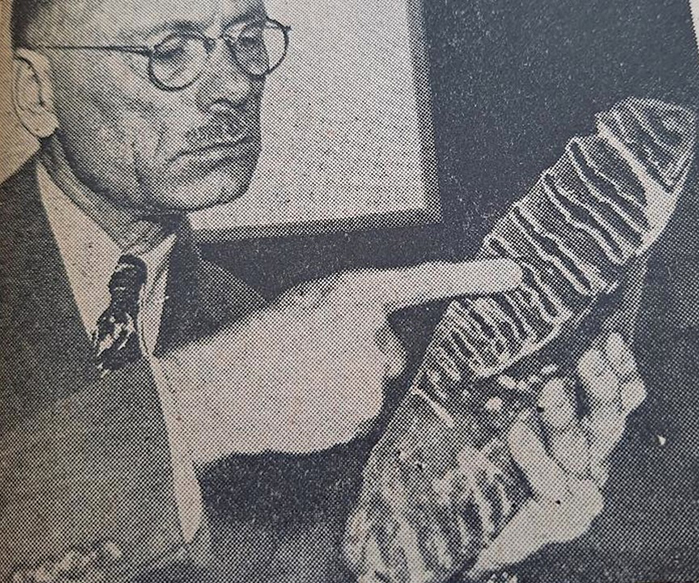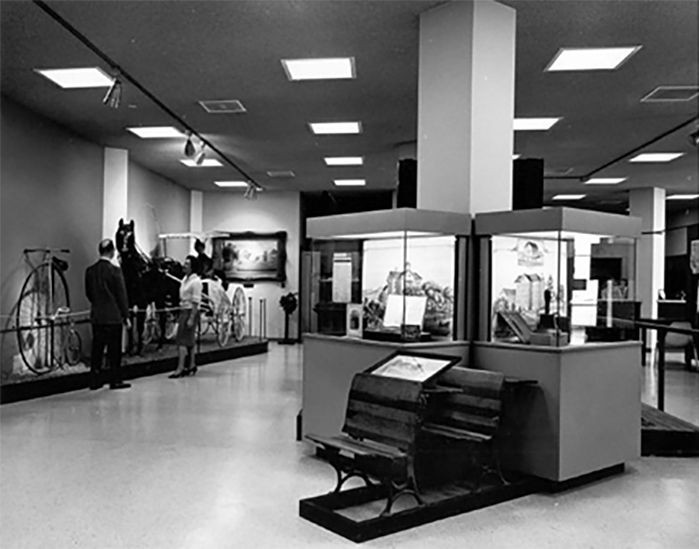San Mateo County History Museum
Farsighted SMJC professor established today’s esteemed collection
The San Mateo County History Museum is one of many community cultural institutions that spun off from College of San Mateo. Now occupying the restored Old County Courthouse in Redwood City, it was housed on campus until 1998.
The great impetus for the collection came from Dr. Frank Stanger (1887–1980), a history professor at what was then San Mateo Junior College. Stanger, a specialist in Latin American history and anthropology who joined SMJC in 1928, was fascinated by the Peninsula’s rich indigenous, Spanish and pioneer history. He was aware that people with firsthand knowledge of pioneer history were fast slipping away.
Stanger also believed that good history teaching requires primary sources. He put out calls in the campus San Matean for artifacts, documents and contact info for old-timers who could give oral histories. Many of the museum’s first pieces were family heirlooms donated by students. They learned to contextualize their heritage in Stanger’s course History of San Mateo County.
The San Mateo County Historical Association, founded in 1935, provided the museum’s nonprofit administrative framework. The museum opened in 1941 in a ground-floor room of SMJC’s Baldwin Avenue campus. Artifact No. 1 in its catalogue is a map drawn by Jerome Hamilton of the Native American shell mounds that once lined San Mateo Creek.
Another rare document was the 1835 will of José Antonio Sánchez, whose 14,639-acre Rancho Buri Buri comprised what is now Millbrae, San Bruno, South San Francisco and part of Burlingame. It was lent by Mildred Kavanaugh ’37, Sanchez’s great-great-granddaughter and a former student in Stanger’s History of San Mateo County.
To encourage students to develop research skills, Stanger launched the Kirkbride Essay Contest. Its sponsor, Charles Kirkbride, was a founder of San Mateo’s public library and high school as well as a member of the college Board of Trustees. From roughly 1939 into the early 1970s, the college gave cash prizes each year to students who submitted the best research papers, using primary sources, on some aspect of San Mateo County life.


Those student papers, still held by the museum, are invaluable resources for today’s researchers because they preserve images and data not held anyplace else, said Carmen Blair, the museum’s deputy director.
“A student might be writing about county transportation in, say, 1940, and he’d include a bus schedule,” Blair said. “Nobody else back then saved stuff like that. These items help us understand ordinary people’s cost of living and their quality of life compared with today.”
The students also took photos, capturing scenes of a time that has long since vanished.
When anything of historical import was discovered in the county, Stanger became the go-to man. Leading a team of students, he supervised the 1943–44 excavations of woolly mammoth skeletons found in construction of the Millbrae Heights housing development. College President Charles S. Morris joined him on the dig to clear the Pleistocene site. They hauled the bulky finds back to campus, initially filling a classroom whose students had to peer around the bones to listen to lecture. (Today, most fossil bones found in the Bay Area are held by the paleontology department at UC Berkeley.)
When CSM moved to College Heights, so did the museum, into a building specially designed for the purpose. In 1972, it became one of only 174 U.S. museums accredited by the American Association of Museums. Still, it and many other beloved cultural entities linked to CSM suffered under state Proposition 13, passed in 1978 to curb property taxes. Direct county support of the museum sank from 60 percent of funding in that year to 10–12 percent in 1981, the museum’s 40th anniversary. The community rallied with an April 1981 fundraising run across the San Mateo Bridge, sponsored by Miller Beer. More lasting support came from Victorian Days in the Park, a yearly arts and history festival in San Mateo Central Park organized and staffed by the historical association and some 200 volunteers.
A 1993 state law that encouraged districts to charge market rent for entities using their buildings threatened further pressure on the museum and led its board to seek a new location. San Mateo County’s turn-of-the-20th-century Beaux-Arts courthouse renovation was completed in 1998, the year the museum’s CSM lease expired, and the museum moved in soon after.
Today, the museum is easily accessible to the public in downtown Redwood City. It displays permanent and changing exhibitions on county life as well as the Peninsula Sports Hall of Fame. Free public programs include the monthly Courthouse Docket, in which experts like CSM emeritus History Prof. Michael Svanevik speak in the museum’s splendid Courtroom A on the county’s past. A plaque there honors U.S. Supreme Court Justice Sandra Day O’Connor, whose first job after law school was as a San Mateo County assistant district attorney in 1953–54.

